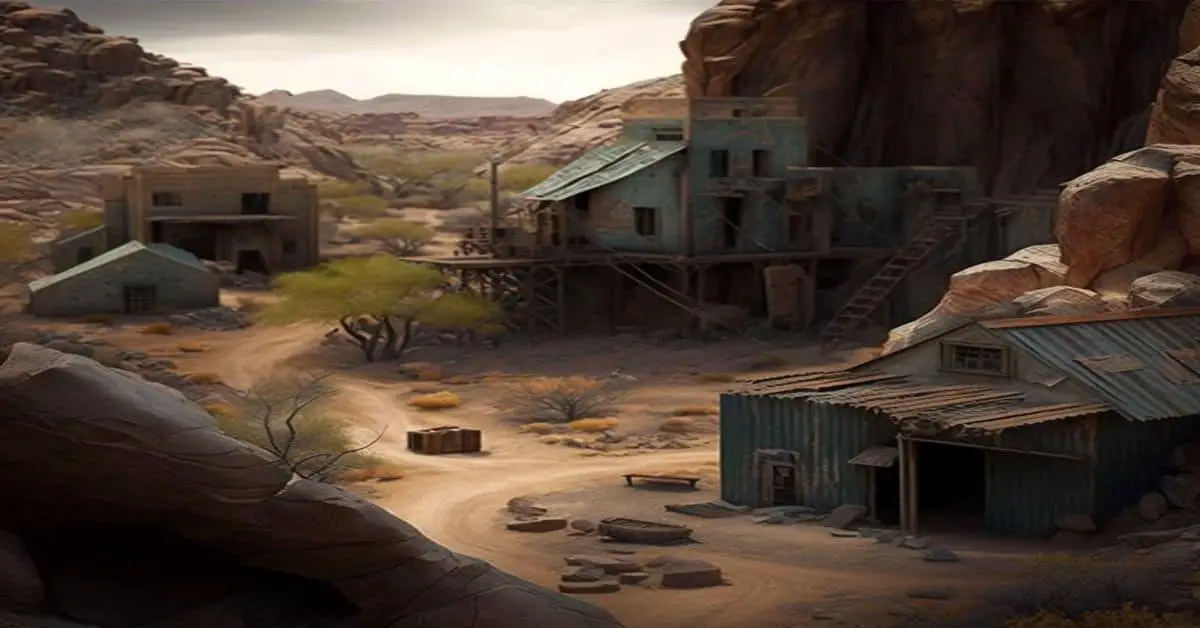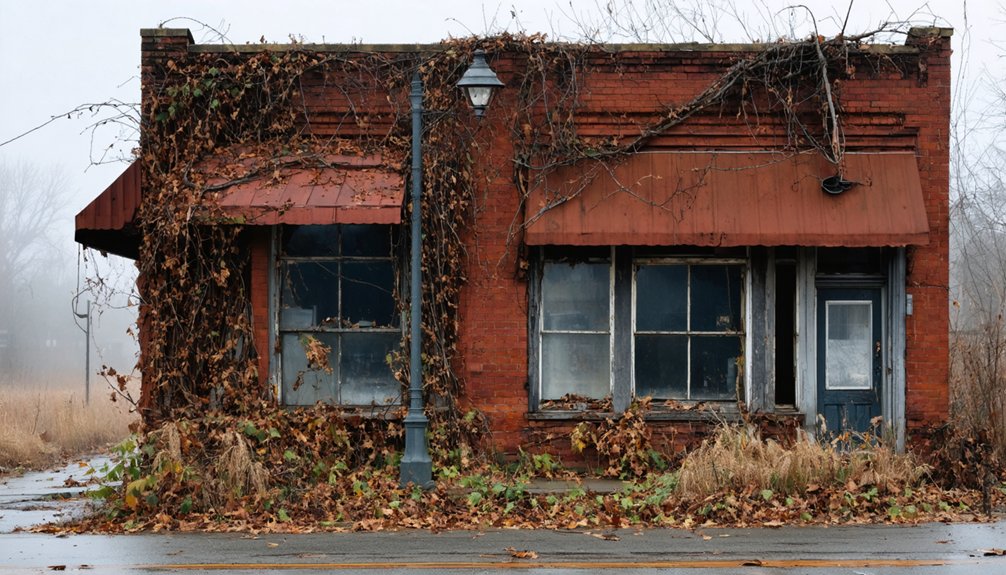You’ll find Prairieville in Clinton County, Indiana, where this former farming community once thrived in Perry Township during the mid-1800s. The settlement grew around a crucial water source but declined due to transportation isolation and economic challenges. While few physical traces remain today, county records confirm its existence through marriage, probate, and court documents from 1830-1888. Local folklore and ghostly encounters have transformed this abandoned town into a fascinating piece of Indiana’s mysterious past.
Key Takeaways
- Prairieville was a small farming community in Perry Township, Indiana that became extinct by the late 19th century.
- The settlement’s decline was primarily due to economic challenges and isolation from railroad transportation routes.
- County records from 1830 onwards document Prairieville’s role as a stagecoach stop and its transition from Miami Indian territory.
- The abandoned town has become known for reported paranormal activity, including sightings of a woman in black.
- Prairieville is among 41 documented ghost towns across Indiana, particularly concentrated in central and southern regions.
Location and Historical Settlement
While historical records mention numerous ghost towns across Indiana, the existence of Prairieville remains uncertain, with no verifiable coordinates, census data, or official documentation confirming its location within the state.
You won’t find Prairieville on any historical maps or in township registries, suggesting it may have been an unofficial settlement or possibly a naming error. Unlike typical Indiana ghost towns that developed around railroads, mills, or mining operations, there’s no evidence of such settlement patterns for Prairieville. The real Prairieville exists as a thriving community of 26,895 residents in Louisiana.
The site’s geographic features remain unknown, with no documented buildings, cemeteries, or roads. If Prairieville existed, it was likely a small agricultural community, following the common trends of 19th-century Indiana settlements. The lack of clarity regarding its location has made it necessary to create disambiguation pages to distinguish it from other similarly named locations.
However, without archaeological surveys or primary sources, its precise location and history remain a mystery.
Rise and Decline of a Prairie Town
Recent historical research has revealed more concrete details about Prairieville’s existence, contradicting earlier uncertainty about its location.
New findings have shed light on Prairieville’s exact location, dispelling previous doubts about where this settlement once stood.
You’ll find that this small farming community in Perry Township initially attracted settlers with its fertile land, serving local agriculture and travelers in the early to mid-1800s. The town grew around a clean water source that made settlement possible.
The town’s decline stemmed from two major factors: economic challenges and transportation issues.
You won’t find evidence of significant industrial growth or commercial enterprises that could’ve sustained the population. When railroads and new highways bypassed Prairieville, leaving it isolated about five miles west of Manson, the town’s fate was sealed.
Like many sites that became extinct, local residents shared stories of personal ghost encounters that added to the settlement’s mysterious legacy. Younger residents moved to areas with better opportunities, while essential services gradually shut down. By the late 19th century, Prairieville had become extinct, with nature reclaiming the settlement‘s remains.
Local Legends and Ghostly Tales
Since Prairieville’s abandonment in the late 19th century, the ghost town has become a focal point for paranormal activity and local folklore.
If you visit the area today, you’ll discover numerous accounts of ghostly encounters, particularly during dusk or on foggy evenings when shadowy figures are known to appear near the abandoned townsite.
The most frequent spectral sightings include a woman in black who wanders the wooded areas, while visitors report hearing disembodied voices and experiencing unexplained cold spots.
You’ll find these phenomena intensify during autumn months and full moons. Electronic devices often malfunction mysteriously, and many visitors describe feeling watched while exploring the ruins.
The named graph database contains historical records of Prairieville’s existence, though little remains of the physical town today.
The haunting tales are deeply rooted in the town’s history of tragedy and hardship, making Prairieville one of Indiana’s most haunted states according to MoveBuddha’s national rankings.
Clinton County Records and Documentation
Through county archives and genealogical research, you’ll discover rich details about this former stagecoach stop from the 1850s. The records maintained by the County Clerk and Recorder’s office provide valuable insights into the community’s development.
- Marriage and probate records dating back to 1830 reveal family connections and property transfers.
- Land records document the change from Miami Indian territory to settlement properties.
- Court records from 1888 onward chronicle legal matters and community disputes.
- Microfilm collections at the Indiana State Library preserve newspapers and county documents that mention Prairieville’s role in local commerce. The area’s transition from wilderness to settlement was chronicled by local historians and pioneers who documented early community life.
You can access these materials through the Clinton County Historical Society‘s online guides and research resources.
Nearby Ghost Towns and Regional Impact
While Prairieville stands as a tribute to Indiana’s vanishing settlements, numerous ghost towns dot the surrounding landscape of Clinton County and neighboring regions.
You’ll find Quaker Point and Randall in Vermillion County, along with Renner in Blackford County, each telling its own tale of decline. These settlements often fell victim to changing transportation routes, industry closures, and shifting economic patterns. The region’s development was shaped by fierce battles during the French and Indian War, as control of the territory shifted between European powers.
Today, you can explore approximately 41 ghost towns across Indiana, with many concentrated in the central and southern regions. Nature has slowly reclaimed these spaces, creating haunting yet beautiful landscapes.
Some structures have been preserved as museums, contributing to ghost town tourism and maintaining regional heritage. Local cemeteries and historic buildings serve as crucial links to your ancestors’ stories, while abandoned rail lines and empty storefronts remind you of the complex forces that shaped Indiana’s rural landscape.
Historical Significance and Cultural Legacy
Located five miles west of Manson in Perry Township, Prairieville stands as a tribute to Indiana’s early transportation history, particularly through its role as an essential stagecoach stop in the 1850s.
The town’s cultural heritage lives on through historical records and local archives, despite its eventual abandonment.
When you explore Prairieville’s historical significance, you’ll discover:
- A bustling inn that accommodated up to 15 travelers, their drivers, and horses during the height of stagecoach travel
- Notable families like the Loveless and Milligan clans who shaped the community’s social fabric
- A demonstration of the economic sustainability challenges faced by rural settlements in the 1800s
- A valuable lesson in how transportation networks influenced the rise and fall of early American communities
Frequently Asked Questions
What Was the Highest Recorded Population of Prairieville During Its Peak Years?
Like chasing a ghost in the wind, you won’t find any recorded peak population for this place. Historical records don’t show any population data or historic significance, let alone details of decline.
Are There Any Remaining Foundations or Structures Still Visible at Prairieville’s Location?
You won’t find any confirmed remaining structures at this location today. While the site holds historical significance as a former stagecoach stop, there’s no documented evidence of visible foundations or ruins.
When Was the Last Known Resident Recorded Living in Prairieville?
You won’t find definitive records of Prairieville’s last resident. Historical documents don’t specify when the final inhabitant left, though local ghost sightings suggest the town was active into the early 1900s.
Did Prairieville Have Its Own Post Office or General Store?
You won’t find records of a post office or general store in historical documents. The post office history and general store significance of Prairieville remain unconfirmed in Indiana’s township-level records.
What Natural Disasters or Events Contributed to Prairieville’s Abandonment?
You’ll find recurring floods were the main natural disaster, causing significant flood damage to buildings and graves while accelerating economic decline as residents sought more stable locations for their homes and businesses.
References
- https://thisisindiana.angelfire.com/indianahauntings.htm
- https://www.youtube.com/watch?v=45D4dbASJyE
- https://indianacountyparks.org/our-trails/ghost-town-trail/ghost-town-trail-history/
- https://womiowensboro.com/ixp/71/p/indiana-is-one-of-the-most-haunted-states-in-america/
- https://kids.kiddle.co/Prairieville
- https://www.familysearch.org/en/wiki/Clinton_County
- https://en.wikipedia.org/wiki/List_of_ghost_towns_in_Indiana
- https://www.wikiwand.com/en/articles/List_of_ghost_towns_in_Indiana
- https://time-ok.com/coordinates/prairieville
- https://en.wikipedia.org/wiki/Prairie_Township



